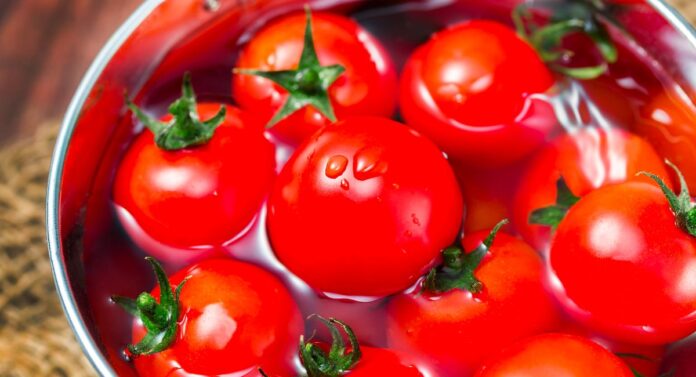India’s tomato market remains weak, due to drought and deluge. This has caused unparalleled price volatility, with tomato prices rising over 300% in certain locations. In the previous several weeks, retail prices have risen to above Rs 200 per kilogram, impacting customers severely. This situation must be addressed. In certain areas, market prices drop below Re 1 per kilogram, hurting farmers’ profits.
India produces 20 million tonnes of tomatoes on 8.4 lakh hectares with an average yield of 24.5 tonnes per hectare in 2022, ranking second in the world. The Indian government has promoted high-yielding varieties and hybrids, protected cultivation, micro irrigation, irrigation infrastructure, post-harvest management, and value addition for decades.
However, the Indian tomato dilemma emphasizes the need for creative solutions. Tomato crop yield may be increased via research and development, stabilizing prices and relieving farmers and consumers. Without ongoing R&D on cutting-edge technology-aided plant breeding, identical crises can arise in any crop at any moment, and one bad monsoon can start a vicious cycle.
New breeding technologies (NBTs) provide promise with their extraordinary capacities. According to Wang, T., Zhang, H., & Zhu, H. (2019), CRISPR (Clustered Regularly Interspaced Short Palindromic Repeats), a promising gene-editing tool, CRISPR has the potential to improve agronomical traits like pest and disease resistance, shelf life, productivity, price stability, and fruit quality, making it a game-changer in tomato breeding.
I. Improving tomato pest and disease resistance with CRISPR. Researchers have created tomatoes with increased disease resistance by targeting certain genes. This new characteristic provides a regular tomato supply even in bad weather, stabilizing market prices. Disease-resistant tomatoes help farmers avoid crop losses, safeguard their livelihoods, and provide markets with tomatoes.
Developing climate-resistant tomato cultivars and hybrids is crucial. Though tomato breeders may not emphasize heat tolerance, rising temperatures due to climate change may eventually need it.
II. Shelf life extension — CRISPR technology extends shelf life beyond disease resistance. CRISPR gene editing has extended tomato shelf life, lowering post-harvest losses. Tomato prices stabilize due to reduced spoilage and waste during storage and shipping. This ensures a consistent supply of fresh tomatoes, lowering prices.
III. Increasing yield – CRISPR can boost tomato output, which benefits farmers. Researchers optimized genes for yield, fruit amount, and crop development to create more productive tomato lines. Increased availability meets customer demand, reducing supply shortage-induced price spikes and creating a win-win situation for farmers and consumers, stabilizing the market.
Despite their promise, sophisticated technologies’ broad adoption in India confronts several obstacles. largely popular opinion. Innovative technology solutions for crop enhancement require clear, science-based policy and regulatory norms. Increasing understanding of the scientific basis, safety, and benefits of novel technologies like gene editing can provide stakeholders confidence in their positive and diverse socioeconomic implications. In this scenario, public-private collaboration is crucial.
In 10 years, NITI Aayog predicts fruit and vegetable demand would surpass 420 million tonnes. India loses over 40% of its billion-dollar horticulture industry. Thus, sustained investments in processing, value addition, and post-harvest management to limit wastage prevent similar crises in tomato and other crops, especially vegetables.
R&D must be encouraged to generate superior cultivars with better agronomical and nutritional qualities. These novel methods can help create a more stable, climate-resilient tomato industry with supportive and evidence-based policy and regulatory frameworks.
The comprehensive strategy may also be used to prevent crises in other vegetable or field crops, maintain food and nutritional security for the 1.4 billion people, and assist India reach its Amrit Kaal goals.
Conclusion:-
India’s tomato market is facing challenges due to drought and deluge, leading to price volatility and affecting farmers’ profits. The country produces 20 million tonnes of tomatoes, ranking second in the world. The government has promoted high-yielding varieties, protected cultivation, micro irrigation, post-harvest management, and value addition for decades. However, the Indian tomato dilemma highlights the need for creative solutions to increase crop yield and stabilize prices. New breeding technologies, such as CRISPR, have the potential to improve agronomical traits like pest and disease resistance, shelf life, productivity, price stability, and fruit quality.
CRISPR has been used to create tomatoes with increased disease resistance, ensuring a regular supply even in bad weather. It also extends tomato shelf life, lowering post-harvest losses and ensuring a consistent supply of fresh tomatoes. Additionally, CRISPR can boost tomato output, benefiting farmers by optimizing genes for yield, fruit amount, and crop development.
However, the broad adoption of these technologies in India faces several obstacles. To prevent similar crises in other crops, sustained investments in processing, value addition, and post-harvest management are needed. R&D should be encouraged to generate superior cultivars with better agronomical and nutritional qualities, creating a more stable, climate-resilient tomato industry with supportive policy and regulatory frameworks.



